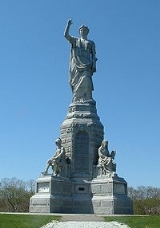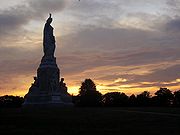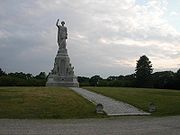
National Monument to the Forefathers
Encyclopedia

Mayflower
The Mayflower was the ship that transported the English Separatists, better known as the Pilgrims, from a site near the Mayflower Steps in Plymouth, England, to Plymouth, Massachusetts, , in 1620...
Pilgrims and honors their ideals as later generally embraced by the United States
United States
The United States of America is a federal constitutional republic comprising fifty states and a federal district...
. The Pilgrim Monument
Pilgrim Monument
For the monument in Plymouth, Massachusetts formerly known as the Pilgrim Monument see National Monument to the ForefathersThe Pilgrim Monument in Provincetown, Massachusetts was built between 1907 and 1910 to commemorate the first landfall of the Pilgrims in 1620 and the signing in Provincetown...
of the present day is in Provincetown, Massachusetts
Provincetown, Massachusetts
Provincetown is a New England town located at the extreme tip of Cape Cod in Barnstable County, Massachusetts, United States. The population was 3,431 at the 2000 census, with an estimated 2007 population of 3,174...
and was built between 1907 and 1910.
Overview

Hammatt Billings, Boston architect, illustrator and sculptor, originally conceived the monument as a 150 feet (45.7 m) structure comparable to the Colossus of Rhodes. Shortly before his death in 1874, Billings reduced the size of the monument, which was to be made entirely of granite
Granite
Granite is a common and widely occurring type of intrusive, felsic, igneous rock. Granite usually has a medium- to coarse-grained texture. Occasionally some individual crystals are larger than the groundmass, in which case the texture is known as porphyritic. A granitic rock with a porphyritic...
. The project was then passed to Billings' brother Joseph who, along with other sculptors including Alexander Doyle, Carl Conrads, and James Mahoney, reworked the design, although the basic components remained. The monument, which faces northeast to Plymouth Harbor (and, roughly, towards Plymouth, England), sits in the center of a circular drive, which is accessed from Allerton Street from the east. The plan of the principal pedestal is octagonal, with four small, and four large faces; from the small faces project four butresses
Buttress
A buttress is an architectural structure built against or projecting from a wall which serves to support or reinforce the wall...
. On the main pedestal stands the heroic figure of "Faith." Upon the four buttresses are seated figures emblematical of the principles upon which the Pilgrims founded their Commonwealth; counter-clockwise from the east are Freedom, Morality, Law and Education. Each was carved from a solid block of granite, posed in the sitting position upon chairs with a high relief on either side of minor characteristics. Under "Freedom" stand "Tyranny" and "Peace;" under "Morality" stand "Prophet" and "Evangelist;" under "Law" stand "Justice" and "Mercy;" and under "Education" are "Youth" and "Wisdom." On the face of the buttresses, beneath these figures are high reliefs in marble
Marble
Marble is a metamorphic rock composed of recrystallized carbonate minerals, most commonly calcite or dolomite.Geologists use the term "marble" to refer to metamorphosed limestone; however stonemasons use the term more broadly to encompass unmetamorphosed limestone.Marble is commonly used for...
, representing scenes from Pilgrim history. Under "Freedom" is "Landing;" under "Morality" is "Embarcation;" under "Law" is "Treaty;" and under "Education" is "Compact." Upon the four faces of the main pedestal are large panels for records. The front panel is inscribed as follows: "National Monument to the Forefathers. Erected by a grateful people in remembrance of their labors, sacrifices and sufferings for the cause of civil and religious liberty." The right and left panels contain the names of those who came over in the Mayflower. The rear panel, which was not engraved until recently, contains a quote from Governor William Bradford's famous history, Of Plymouth Plantation
Of Plymouth Plantation
Written over a period of years by the leader of the Plymouth Colony in Massachusetts, William Bradford, Of Plymouth Plantation is the single most complete authority for the story of the Pilgrims and the early years of the Colony they founded...
:
- "Thus out of small beginnings greater things have been produced by His hand that made all things of nothing and gives being to all things that are; and as one small candle may light a thousand, so the light here kindled hath shone unto many, yea in some sort to our whole nation; let the glorious name of Jehovah have all praise."
The overall scheme was designed by architect Hammatt Billings
Hammatt Billings
Charles Howland Hammatt Billings was an artist and architect from Boston, Massachusetts.Among his works are the original illustrations for Uncle Tom's Cabin ,...
, with subsidiary statues executed by area sculptors including William Rimmer
William Rimmer
William Rimmer was an American artist born in Liverpool, England. He was the son of a French refugee, who emigrated to Nova Scotia, where he was joined by his wife and child in 1818, and who in 1826 moved to Boston, where he earned a living as a shoemaker...
.
National Register
The monument was listed on the National Register of Historic PlacesNational Register of Historic Places
The National Register of Historic Places is the United States government's official list of districts, sites, buildings, structures, and objects deemed worthy of preservation...
on August 30, 1974. Originally under the care of the Pilgrim Society, it was given to the Massachusetts
Massachusetts
The Commonwealth of Massachusetts is a state in the New England region of the northeastern United States of America. It is bordered by Rhode Island and Connecticut to the south, New York to the west, and Vermont and New Hampshire to the north; at its east lies the Atlantic Ocean. As of the 2010...
government in 2001. It and Plymouth Rock
Plymouth Rock
Plymouth Rock is the traditional site of disembarkation of William Bradford and the Mayflower Pilgrims who founded Plymouth Colony in 1620. It is an important symbol in American history...
constitute the Pilgrim Memorial State Park
Pilgrim Memorial State Park
Pilgrim Memorial State Park comprises two monuments in Plymouth, Massachusetts: Plymouth Rock and the National Monument to the Forefathers. Closely related to these memorials is the Myles Standish Monument State Reservation which can be seen across the Plymouth Bay in Duxbury, Massachusetts...
. Although intended as national in scope, the Forefathers Monument is not a federal "National Monument
U.S. National Monument
A National Monument in the United States is a protected area that is similar to a National Park except that the President of the United States can quickly declare an area of the United States to be a National Monument without the approval of Congress. National monuments receive less funding and...
" as understood today from the Antiquities Act of 1906
Antiquities Act
The Antiquities Act of 1906, officially An Act for the Preservation of American Antiquities , is an act passed by the United States Congress and signed into law by Theodore Roosevelt on June 8, 1906, giving the President of the United States authority to, by executive order, restrict the use of...
.

